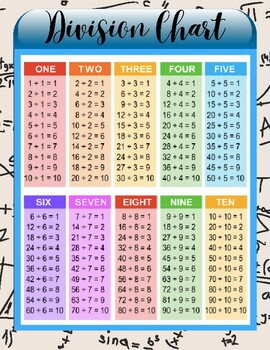Division Reference Chart
The Profound Teacher
23 Followers
Grade Levels
2nd - 12th, Higher Education, Adult Education, Homeschool, Staff
Subjects
Resource Type
Standards
CCSS6.EE.A.1
CCSS6.EE.A.2b
CCSS6.EE.A.2c
CCSS6.EE.B.5
CCSS6.EE.B.6
Formats Included
- PDF
The Profound Teacher
23 Followers
Description
Division mathematics reference sheet. Colorful, kid-friendly way to remind students of their division facts.
Intervention / MTSS / RTI / AIS / Special Education / homeschool
tiered instruction / strengths based / reference / differentiation / pre-made notes
Grades 2 - 12 - adult / Danielson's Framework / presentation
Elementary, Middle, High School - adult / Danielson's Framework / presentation
Division Reference Chart by The Profound Teacher is licensed under a Creative Commons Attribution 4.0 International License.
Total Pages
Answer Key
N/A
Teaching Duration
N/A
Report this resource to TPT
Reported resources will be reviewed by our team. Report this resource to let us know if this resource violates TPT’s content guidelines.
Standards
to see state-specific standards (only available in the US).
CCSS6.EE.A.1
Write and evaluate numerical expressions involving whole-number exponents.
CCSS6.EE.A.2b
Identify parts of an expression using mathematical terms (sum, term, product, factor, quotient, coefficient); view one or more parts of an expression as a single entity. For example, describe the expression 2 (8 + 7) as a product of two factors; view (8 + 7) as both a single entity and a sum of two terms.
CCSS6.EE.A.2c
Evaluate expressions at specific values of their variables. Include expressions that arise from formulas used in real-world problems. Perform arithmetic operations, including those involving whole-number exponents, in the conventional order when there are no parentheses to specify a particular order (Order of Operations). For example, use the formulas V = s³ and A = 6 s² to find the volume and surface area of a cube with sides of length s = 1/2.
CCSS6.EE.B.5
Understand solving an equation or inequality as a process of answering a question: which values from a specified set, if any, make the equation or inequality true? Use substitution to determine whether a given number in a specified set makes an equation or inequality true.
CCSS6.EE.B.6
Use variables to represent numbers and write expressions when solving a real-world or mathematical problem; understand that a variable can represent an unknown number, or, depending on the purpose at hand, any number in a specified set.




